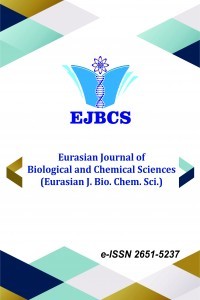Synthesis of Biologically Active 4-Arylideneamino-2,4-dihydro-3H-1,2,4-triazol-3- one Compound by Ultrasonic Radiation and Conventional Method, Comparison of Methods and Elucidation of Structure
Synthesis of Biologically Active 4-Arylideneamino-2,4-dihydro-3H-1,2,4-triazol-3- one Compound by Ultrasonic Radiation and Conventional Method, Comparison of Methods and Elucidation of Structure
Today, the majority of the drugs used in the treatment of diseases are obtained by synthesis. A large proportion of the compounds have obtained heterocyclic structure. Therefore, synthesis of new heterocyclic compounds has always attracted and continues to attract scientist. It is known that compounds bearing triazole skeleton in the heterocyclic have an important place. The reactions of 4-amino-triazole compounds, especially with aromatic aldehydes, have been known for a long time and this reaction is carried out by conventional heating methods. However, the development of alternative heating methods to these conventional methods has also recently been studied. One of the most important of these is organic synthesis by microwave method and it is widely used. Another alternative method that has recently been used in organic synthesis is the realization of organic synthesis reactions with ultrasonic radiation. Ultrasound-assisted organic synthesis is an environmentally friendly, modern and economical method used to accelerate reactions. In this study, optimum conditions were determined for this reaction by using ultrasonic radiation method and the results were compared with the classical method. For this purpose, in the first step iminoester was synthesized by using Pinner method. The reaction of this iminoester with ethylcarbazate gave the corresponding hydrazone. Then the reaction of this obtained hydrazone derivative with hydrazine hydrate, the 4-amino-1,2,4-triazole derivative compound was synthesized. In the final reaction step, the interaction of this amino compound with 3-bromo-4-fluorobenzaldehyde was carried out by conventional and novel method (ultrasonic radiation) to obtain the targeted imine compound. The chemical structure of the new compound will be determined by spectroscopic methods such as 1H- and 13C-NMR and IR. The results compared in terms of reaction time, yield and purity between conventional and ultrasonic method. And we found that the ultrasonic radiation method is much more advantageous.
Keywords:
ultrasonic radiation, Conventional synthesis Iminoester, Schiff base,
___
- Alissa SA. 2014. Ultrasound synthesis of five membered heterocycles. Chem Sci Rev Let. 3(12):1219-1236.
- Gogate P, Pandit, AB, Tayal RK. 2006. Cavitation: A technology on the horizon. Current Science. 91(1):35-46.
- https://www.slideshare.net/wimbaji/ultrasonic-application-in-chemical-engineering-presentation [20.02.2020].
- İkizler A, Demirbaş N, Demirbaş A, İkizler AA. 1996. The reaction of Ester Etohoxycarbonyl hydrazones with carboxylic acid hydrazides. Polish J Chem. 70:1114-1120.
- İkizler AA, Yıldırım N. 1991. Synthesis of some benzylidenamino compounds. Monatsch Chem. 122:557-563.
- Kahveci B, İkizler A. 2000. Convenient synthesis of some 4-(Alkylamino)-4,5-dihydro-1H-1,2,4-triazol-5-ones. Turk J Chem. 24:343- 351.
- Kahveci B. 2005. Synthesis of 4-amino-4,5-dihydro-1H-1,2,4-triazole-5-ones and their isatin-3-imine derivatives. Molecules. 10:376-382.
- Layer RW. 1963. The chemistry of imines. Chemical Reviews. 63:489-510.
- Mason TJ, Lorimer JP. 2002. Applied Sonochemistry: Uses of Power Ultrasound in Chemistry and Processing. By Timothy J Mason and John P Lorimer, Wiley‐VCH Verlag, Weinheim, 2002, 303 pp, ISBN 3‐527‐30205‐0
- Pinner A. 1892. Die imidoether und ihne Derivate, 1.Auflaze, Oppenheim, Berlin.
- Pretsch E, Clerk T, Seibl J, Simon W. 1983. Tables of spectral data for structure determination of organic compounds. Berlin: Springer-Verlag.
- Sarpong R. 2003. Ultrasound Applications in Organic synthesis, Stoltz Literature Meeting.
- Silverstein RM, Webster FX. 1998. Spectrometric identification of organic compounds. New York: John Wiley & Sons Inc.
- Thompson LH, Doraiswamy LK. 1999. Sonochemistry: Science and Engineering. Ind Eng Chem Res. 38(4):1215-1249.
- Yayın Aralığı: Yılda 2 Sayı
- Başlangıç: 2018
- Yayıncı: Muhammet DOĞAN
